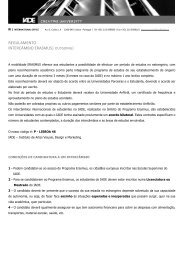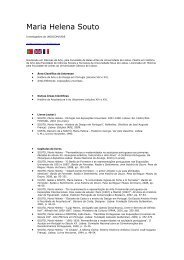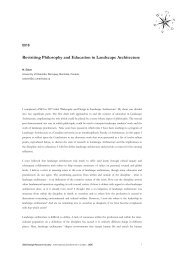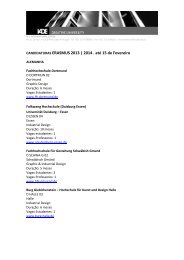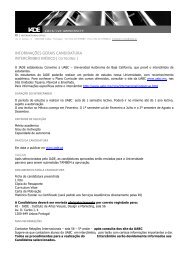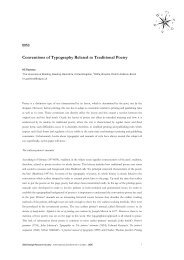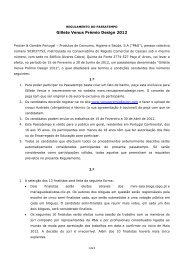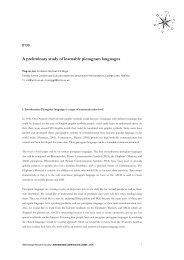Open PDF - Iade
Open PDF - Iade
Open PDF - Iade
Create successful ePaper yourself
Turn your PDF publications into a flip-book with our unique Google optimized e-Paper software.
KONDRATIEFF WAVE CONCEPTS VS GOLDEN AGE FOR INDUSTRIAL DESIGN::<br />
CARLOS A. M. DUARTE<br />
Ph.D.; Associated Professor;<br />
IADE – Design School and researcher member of UNIDCOM/IADE<br />
Av. Dom Carlos I, n.º 4, 1200-649 Lisbon, Portugal<br />
cduarte@iade.pt<br />
Abstract:<br />
This paper is about new perspective on the history of golden age for Industrial Design. It can be a promising<br />
approach to correlate Kondratieff waves, especially the dominant technologies in the respective periods; to<br />
cycles / periods / fashions / ideologies / ... of design. All along the 20 th century the strategies used by<br />
economic agents to create competitive products have lead to the evolution and diversity of Design. It was a<br />
time characterized by the systematic application of scientific knowledge to the resolution of economic<br />
problems, aiming the sustainable growth of the life-standard of people.<br />
The new materials and the new technologies at principle of century XXI are a challenge for designers. They<br />
begin to make use of a bigger shared area of action. They provide a very important and accessible operating<br />
principle bridging science and history, and their understanding would fill the existing lack to operacionalize<br />
the long wave approach as a useful forecasting tool. We consider that there exists indeed a connection<br />
between what happens in the global socio-economic realm and the evolution of Design that, as we know, is<br />
strongly related to the context of the technologies developed in the corresponding periods. This finding<br />
allows alerting Designers to the probably time span involving the entire life cycle of a product, since its<br />
conception till elimination of the market; however the variety of products and forms will probably continue to<br />
expand. The importance of Design will continue to grow.<br />
Within this general picture of reference, the role of Industrial Design can be synthesized as the activity that<br />
relates the technically possible with the culturally acceptable. Such activity allows confronting the set of<br />
relations depending of numerous interactions among the aggregation of several elements that connect them,<br />
and make them multidisciplinary. It is known that the values of product design are located in between the<br />
identities of things and the time at which they are embedded, in the realm of the effective socio-economic<br />
systems.<br />
1
Some recent discoveries are presented suggesting a strong relationship between some socio-economic<br />
aspects of the long economic cycles (Kondratieff waves) and the known periods of the history of Design. It<br />
was found that amid the apparently random oscillations of the informational content, at least two<br />
characteristic periods of 25-30 and 50-60 years were present. We may conclude that there exists indeed a<br />
connection between what happens in the global socio-economic realm and the evolution of Design that, as<br />
we know, is strongly related to the context of the technologies developed in the corresponding periods. This<br />
finding allows alerting designers to the probably time span involving the entire life cycle of a product, since its<br />
conception till elimination of the market. The paper is a preliminary exploration of a challenging and difficult<br />
topic, linking design history with broad economic and technological cycles.<br />
Keywords: History of Industrial Design; Long Waves; Kondratieff Cycles.<br />
1. Introduction<br />
During the 20th century, the scientific interest in design process has grown rapidly. We have seen an<br />
amazing transformation of our society from that of hand-made consumer goods designed and made by<br />
skilled craftsmen to one of mass-production with new materials and technologies. Design is everywhere.<br />
Design history is not merely a chronology of objects and their forms, but a record of the forms of life,<br />
because the relation of human beings to the objects they produce and use reflects, especially in the last<br />
century, a large segment of cultural history (Carvalho Rodrigues, et al., 2001).<br />
The world economic depression of the 1980’s witnessed a growing confrontation, between traditional<br />
functionalism and new designing principle that rejected the old models of design-simplicity, reduction to pure<br />
function, and also the definition of industrial mass production. Since the onset of the world economic<br />
depression there has been, too, a renewed worldwide interest in the study of long-term macroeconomic<br />
rhythms, most commonly referred to as long waves or Kondratieff waves (Devezas, 2000).<br />
In last years, the theory of long waves is a very useful tool to construct future scenarios, not only regarding<br />
the future of technology, but also the future of human reasoning (morals, ethics, and common values). In this<br />
study, the authors analysed the relationship between some socioeconomic aspects of the long economic<br />
cycles (Kondratieff waves) and the known periods of the history of Design (Hauffe, 1998) and their social<br />
impact.<br />
2. The Kondratieff Waves<br />
The Kondratieff Cycle is a theory based on a study of nineteenth century price behavior which included<br />
wages, interest rates, raw material prices, foreign trade, bank deposits, and other data. Kondratieff was<br />
convinced that his studies of economic, social, and cultural life proved that a long term order of economic<br />
behavior existed and could be used for the purpose of anticipating future economic developments. The<br />
Kondratieff cycle (or long wave) theory holds that capitalistic economies grow in a cyclic fashion with an<br />
average periodicity between 50 to 60 years (Duarte, 2001). It was identified four Kondratieff cycles<br />
(Devezas, 1996). There is today very strong and robust empirical evidence of the existence of these long<br />
waves in world economic activity (Marchetti, 1986). The cluster of innovations at the start of each wave is<br />
associated with a shift towards a new technological transformation, with a combination of new technologies,<br />
the development of new industrial activities and a deep transformation of human behaviour (Devezas, 1999).<br />
Each new technology system grows logistically until it reaches market saturation and then declines and<br />
begins to be replaced by a newer technology system - there is a successive alternation of growth and<br />
decadence with duration of 50 - 60 years (Devezas, 1997).<br />
2
Devezas and Corredine (2001a), describe the long wave behaviour in socioeconomic growth and<br />
development how is essentially biologically driven. This swinging behaviour is a natural manifestation of<br />
social systems as a response to their survival and improvement capability, that is, for their evolution in the<br />
most pure Darwinian logic (Devezas and Corredine, 2002).<br />
Thus each long wave can be conceived as an evolving learning dissipative structure bounded by instabilities.<br />
At each long wave a new technoecomic environment is created, used and exhausted, following the path of<br />
an overall logistic curve, dragging within it not only new technologies and industries, but new ways of life,<br />
new occupations, new forms of organization, not only in business but also in politics and social order.<br />
The first one is triggered during the ceiling (saturation) of the previous technoeconomic system, a period of<br />
high instability corresponding to economic stagnation and recession, soon followed by a deep economic<br />
depression, the downswing of the long wave. It corresponds to a phase of renovation, mutation, and<br />
selection, during which basic innovations accumulate and interact synergistically, and new ideas emerge<br />
apparently out of nowhere. Society begins to deal with a new technological environment, while old structures<br />
collapse and gives place to the emergence of new ones. This process takes time and the endogenous mode<br />
of operation is the rate of achievement of basic knowledge, or in other words, the rate of learning, dominated<br />
by a new cohort leading generation (Devezas and Corredine, 2001b). Once the necessary knowledge is<br />
established and accumulated, the new technological environment expands throughout society, new<br />
infrastructures are built in great scale, and a phase of economic expansion starts again, carrying the upswing<br />
of the long wave. It corresponds to the second structural cycle, a phase of consolidation and maturing. Now<br />
the endogenous mode of operation is the rate of consolidation of knowledge, again a rate of learning, but<br />
now corresponding to the transfer of relevant knowledge to the following leading generation and designers<br />
for tomorrow.<br />
3. Kondratieff waves and the periods of the history of golden age for Industrial Design<br />
This relationship between some socioeconomic aspects of the long economic cycles (Kondratieff waves) and<br />
the known periods of the history of golden age for Industrial Design, starting at the end of the Second War,<br />
as well as the Kondratieff fourth wave.<br />
Before, at brief introduction, the period between two world wars and socialist revolution in Russia (1917) and<br />
in Germany (1918), the Kondratieff third wave was marked by radical economic and social changes in all the<br />
industrial nations and appoint the average of 3 rd Kondratieff wave, try to be reconciled art and technology. Art<br />
into Life, Futurism, Constructivism; The Soviet Union – Vladimir Tatlin; The Netherlands and De Stijl – Piet<br />
Mondrian and Gerrit Thomas Rietveld; The Bauhaus – Walter Gropius and Ludwig Mies van der Rohe; The<br />
International Style – Le Corbusier, Marcel Breuer and Alvar Aalto. So many new industrial activities brought<br />
to economics the factor of complexity, ever growing since the beginning of 20 th century. But the synergistic<br />
aspect of this wave was very strong. The chemistry industry expanded very fast, as the growing use of<br />
textiles triggered greater use of soaps, bleaches and dyes (Bayer and Hoechst were founded in 1870!). The<br />
steel industry, as well as the petrochemical industry, opened the way for the internal combustion engine -<br />
this was the birth of the automobile, and soon after that of the airplane. The rapid expansion of the<br />
automobile industry triggered the expansion of another branch of industry- the Portland cement industry for<br />
the construction of paved road networks. It is important to observe the synergistic combination of telephone<br />
and road networks - the necessity of a more efficient communication system as individual freedom of<br />
movement grew.<br />
More lately, with the end of third wave in its depression phase, an age of contrasts, in Germany, war,<br />
revolution, and economic crises resulted in massive unemployment and poverty. The Wall Street Crash of<br />
1929 is the dividing line between the '20s and the '30s and between European ‘moderne’ and American<br />
‘streamlining’. The secondary plateau ends with a sudden shock (financial panic/stock market crash) and the<br />
economy rolls over into the next contractionary phase, which is characterized by deflation and the start of an<br />
economic depression. The other side, the financial elite maintained its previous life-style. Extravagant<br />
3
decoration gave way to greater simplicity and restraint in design to allow easy machine mass-production,<br />
and cheap prices. A new profession emerged in the 1930s, as industrial designers applied art deco styling to<br />
consumer products, to attract Depression buyers. American popular culture was fast becoming the country’s<br />
top export.<br />
Art Deco and industrial design – Henry Dreyfus and Norman Bel Geddes; Design in the Third Reich and the<br />
Volkswagen, a car for every person, known to most of the world as the “Beetle”. Its cluster of innovations<br />
began during the recession of the 1930’s and expanded during and shortly after the II World War. The<br />
radical technological innovation is the Fermi’s battery (1942), with the introduction of radio, television, and<br />
computers, synthetic materials (plastics and polymer fibbers). Alvar Aalto, a Finnish architect emerges in<br />
Scandinavia, and he remains one of the most individual and poetic masters of functionalism in modern<br />
architecture and furniture design.<br />
With the end of the Second War and the Kondratieff fourth wave (Fig. 1), the first relevant period of the<br />
history of golden age for Industrial Design is knowing by “The Economic Miracle” (1945-1960) with the<br />
petroleum as a dominant energy (50% in 1970).<br />
Fig. 1.<br />
4 th Kondratieff wave and the periods of the History of golden age for Industrial Design with two characteristic<br />
periods of 25-30 years.<br />
Start a new wave and new phase of economic expansion. The post-war period and the 1950’s, brought<br />
about deep changes not only in politics but also in international style. The so-called American way of life<br />
(Raymond Loewy) influenced almost all areas of life and culture. The United States of America takes the<br />
lead. The Marshall Plan begins in 1947 to help rebuild Europe. In 1957 the Treaty of Rome establishes the<br />
European Economic Union. But the most significant development was the invention of the transistor in 1947<br />
at Bell Telephone’s laboratory, a new radical technological innovation, which enabled the miniaturization of<br />
electrical products. In 1959, Sony produced their first transistorised television, an incremental technological<br />
innovation.<br />
The 1950s were a fertile time in the history of the furniture industry. Designers with backgrounds in<br />
architecture created organically shaped pieces using the new technologies and materials developed during<br />
the war. Organic Design – Charles Eames, Art and Design (the Italian economic miracle) – Alpha Romeo<br />
and Ferrari. Italian style was marked by improvisation – Achille Castiglioni, Good Form and Theoretical<br />
Foundations – the Ulm model in Germany and Scandinavian home design. In 1960’s the technology and<br />
prosperity had an influence on Design and the patterns of consumption in America and Europe – “Good<br />
Form and Bel Design” (1954-1968).<br />
The economic boom lasted up to 1964 in the United States, allowing it to lead the world in all areas of<br />
consumer culture, industrial design, and manufacturing. This was due to high demand for American-made<br />
products, and particularly to the rapid development and advance in technology: in transportation, space<br />
exploration, communication, and even the processing of the new plastics to introduce products with new<br />
forms and colours. Design utopias; German design and ergonomics (Dieter Rams and the Braun<br />
Corporation); Italy and bel design (Mario Bellini and the Olivetti); Synthetic Materials (Verner Panton); the<br />
plastic wave (Joe Colombo and Kartell). The emerging role of industrial designers covered issues not only of<br />
fabrication and aesthetics, but human engineering, ergonomics and market research.<br />
4
The next period “Experimentation and Antidesign” (1965-1976), corresponding to economic stagnation and<br />
recession, soon followed by a deep economic depression. It corresponds to a phase of renovation, mutation,<br />
and selection, new ideas emerge apparently out of nowhere. The crisis of functionalism, pop design,<br />
alternative design, recycling design – the Woodstock festival and culture of “flower power”; the miniskirt<br />
(Mary Quant) spread throughout the world; furniture made by PVC become stylish as the essence of<br />
youthfulness and flexibility.<br />
The “Postmodernism” (after 1968) corresponding to the recession phase of the present wave - new technical<br />
and process innovations. Redesign with Studio Alchimia and Memphis (Alessandro Mendini and Ettore<br />
Sottsass); New Design (Ron Arad, Jasper Morrison, Oscar Tusquets Blanca, Javier Mariscal, Jean-Paul<br />
Gaultier and Philippe Starck). In the nineties the effects of technological advances are wide-spread.<br />
In 1989, dismantling of the Berlin Wall. Dissolution of the Soviet Union at 1991 and the Maastricht Treaty<br />
strengthens the European Community in 1992. The High-tech Design and miniaturization (for example: Sony<br />
and Japanese design) and the current use the computers and the growth of the internet, as a radical<br />
innovation for the common of us. With the design boom of the 1980’s the products assumed the images of<br />
the corporation as well as for the consumer, an example: the Swatch – Design and Marketing. The relation of<br />
New Design to art. The interdisciplinary connections between the applied arts, art, media and industry.<br />
Designing for comfort and ergonomics became an increasing concern of designers as environmental issues<br />
proliferated. The world ecology, wildlife and health issues inspired designers to explore functionalism in<br />
entirely new ways: Ecologic Design and sustainable.<br />
So, much controversy exists on whether the Kondratieff wave is valid for the post II World War economy. If<br />
the 50-60 year cycle were based on generation aspects, then it would naturally be 'stretched' beyond 60<br />
years. Since these cycles of wars and economic birth and renewal occur every 2-3rd generation, it’s possible<br />
to say that when the generation to last see a depression dies off, it's time for another cycle to begin. Maybe<br />
we can say that the deferent’s periods of design depends of the economic cycles, how we can be<br />
synthesized this activity that relates the technically possible with the culturally acceptable.<br />
4. Conclusions<br />
The Kondratieff wave concept provides a very important and accessible operating principle bridging science<br />
and history, and their understanding would fill the existing lack to operacionalize the long wave approach as<br />
a useful forecasting tool. Some recent discoveries are presented suggesting a strong relationship between<br />
some socio-economic aspects of the long economic cycles (Kondratieff waves) and the known periods of the<br />
history of Design. It was found that amid the apparently random oscillations of the informational content, at<br />
least two characteristic periods of 25-30 and 50-60 years were present.<br />
We may conclude that there exists indeed a connection between what happens in the global socioeconomic<br />
realm and the evolution of Design that, as we know, is strongly related to the context of the technologies<br />
developed in the corresponding periods. This finding allows alerting designers to the probably time span<br />
involving the entire life cycle of a product, since its conception till elimination of the market; however the<br />
variety of products and forms will probably continue to expand. The importance of Design will continue to<br />
grow.<br />
5
5. References<br />
Carvalho Rodrigues, F.; Duarte, Carlos A. M.; Ribeiro, André S.; Devezas, Tessaleno C.; Côrte-Real,<br />
Eduardo (2001). Quantidade de Informação na Arquitectura Portuguesa, 1050-1950. Academia das<br />
Ciências de Lisboa.<br />
Devezas, Tessaleno C. and Corredine, James T. (2002). The nonlinear dynamics of technoeconomic<br />
systems: an informational interpretation. Technological Forecasting & Social Change, 69, pp. 317-357.<br />
Devezas, Tessaleno C. and Corredine, James T. (2001a). The Biological Determinants of Long Wave<br />
Behavior in Socioeconomic Growth and Development. Technological Forecasting & Social Change, 68,<br />
pp. 1-57.<br />
Devezas, Tessaleno C. (2001b). Cycles Patterned Repetition or Chaotic Behaviour. 21st International<br />
Symposium on Forecasting, Callaway Gardens, Atlanta, USA.<br />
Devezas, Tessaleno C. (2001c). The Causality of Long Waves. Presented at the 4th International Kondratieff<br />
Conference, Moscow, Russia.<br />
Devezas, Tessaleno C. (2000). Learning Dynamics of Technological Progress. 3rd International Meeting of<br />
the Research Committee on Sociocybernetics (ISA/RC51), Panticosa.<br />
Devezas, Tessaleno C. (1999). Diffusion-Learning Subsystem Dynamics: A new approach to explain long<br />
waves in socioeconomic development. 2nd International Meeting of the Research Committee on<br />
Sociocybernetics (ISA/RC51), Crete.<br />
Devezas, Tessaleno C. (1997). The Impact of Major Innovations: Guesswork or Forecast. Journal of Future<br />
Studies, Volume 1(2), pp 33-50.<br />
Devezas, Tessaleno C. (1996). Succeeding Technospheres. Presented as "From Smart Materials to<br />
Intelligent Structures: A Future Survey. 8th General Assembly of the World Future Society", Washington<br />
D.C., USA.<br />
Duarte, Carlos A. M. (2001). Análise Relativista da Quantidade de Informação para Avaliação de<br />
Comportamentos Emergentes no Design. Covilhã, Universidade da Beira Interior.<br />
Hauffe, Thomas (1998). Design – A Concise History. Laurence King Publishing, London.<br />
Marchetti, Cesare (1986). Fifty-Year Pulsation in Human Affairs. Futures, 17 (3), pp. 376-378.<br />
6





